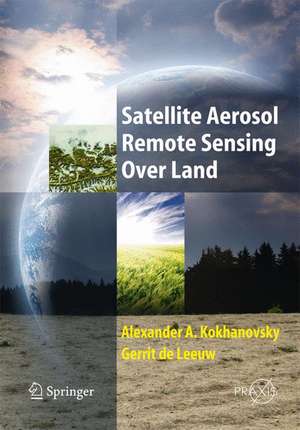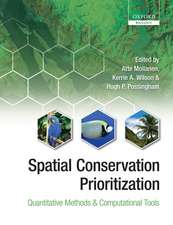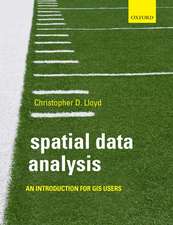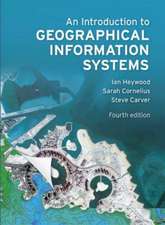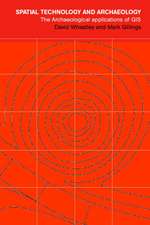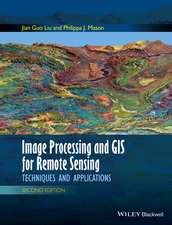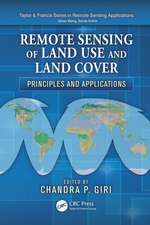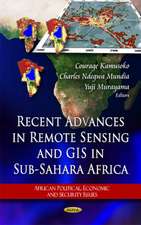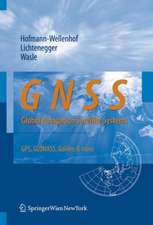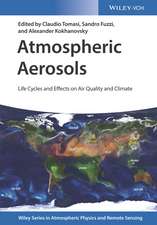Satellite Aerosol Remote Sensing Over Land: Springer Praxis Books
Autor Alexander A. Kokhanovsky, Gerrit de Leeuwen Limba Engleză Hardback – 20 mar 2009
Satellite Aerosol Remote Sensing Over Land is the only book that brings together in one volume the most up-to-date research and advances in this discipline. As well as describing the current academic theory, the book presents practical applications, utilizing state-of-the-art instrumentation, invaluable to the work of environmental scientists.
With contributions by an international group of experts and leaders of correspondent aerosol retrieval groups, the book is an essential tool for all those working in the field of climate change.
| Toate formatele și edițiile | Preț | Express |
|---|---|---|
| Paperback (1) | 1050.20 lei 38-44 zile | |
| Springer Berlin, Heidelberg – 11 noi 2010 | 1050.20 lei 38-44 zile | |
| Hardback (1) | 1225.52 lei 6-8 săpt. | |
| Springer Berlin, Heidelberg – 20 mar 2009 | 1225.52 lei 6-8 săpt. |
Din seria Springer Praxis Books
-
 Preț: 292.32 lei
Preț: 292.32 lei -
 Preț: 221.79 lei
Preț: 221.79 lei -
 Preț: 191.68 lei
Preț: 191.68 lei -
 Preț: 166.59 lei
Preț: 166.59 lei -
 Preț: 286.87 lei
Preț: 286.87 lei -
 Preț: 321.37 lei
Preț: 321.37 lei -
 Preț: 373.33 lei
Preț: 373.33 lei -
 Preț: 262.20 lei
Preț: 262.20 lei - 8%
 Preț: 513.82 lei
Preț: 513.82 lei -
 Preț: 188.60 lei
Preț: 188.60 lei -
 Preț: 216.55 lei
Preț: 216.55 lei -
 Preț: 309.79 lei
Preț: 309.79 lei - 17%
 Preț: 401.17 lei
Preț: 401.17 lei -
 Preț: 214.82 lei
Preț: 214.82 lei -
 Preț: 260.37 lei
Preț: 260.37 lei -
 Preț: 262.44 lei
Preț: 262.44 lei -
 Preț: 166.38 lei
Preț: 166.38 lei -
 Preț: 257.63 lei
Preț: 257.63 lei -
 Preț: 257.20 lei
Preț: 257.20 lei -
 Preț: 303.24 lei
Preț: 303.24 lei -
 Preț: 232.29 lei
Preț: 232.29 lei -
 Preț: 226.17 lei
Preț: 226.17 lei -
 Preț: 258.07 lei
Preț: 258.07 lei -
 Preț: 293.42 lei
Preț: 293.42 lei -
 Preț: 354.57 lei
Preț: 354.57 lei -
 Preț: 273.79 lei
Preț: 273.79 lei -
 Preț: 255.22 lei
Preț: 255.22 lei -
 Preț: 347.16 lei
Preț: 347.16 lei -
 Preț: 270.48 lei
Preț: 270.48 lei -
 Preț: 268.32 lei
Preț: 268.32 lei - 8%
 Preț: 430.08 lei
Preț: 430.08 lei -
 Preț: 324.65 lei
Preț: 324.65 lei - 8%
 Preț: 391.91 lei
Preț: 391.91 lei -
 Preț: 318.31 lei
Preț: 318.31 lei -
 Preț: 322.92 lei
Preț: 322.92 lei -
 Preț: 251.28 lei
Preț: 251.28 lei -
 Preț: 191.44 lei
Preț: 191.44 lei -
 Preț: 311.13 lei
Preț: 311.13 lei -
 Preț: 149.38 lei
Preț: 149.38 lei -
 Preț: 231.60 lei
Preț: 231.60 lei -
 Preț: 284.71 lei
Preț: 284.71 lei -
 Preț: 210.43 lei
Preț: 210.43 lei -
 Preț: 364.15 lei
Preț: 364.15 lei -
 Preț: 272.70 lei
Preț: 272.70 lei -
 Preț: 230.54 lei
Preț: 230.54 lei -
 Preț: 282.51 lei
Preț: 282.51 lei -
 Preț: 210.87 lei
Preț: 210.87 lei -
 Preț: 158.62 lei
Preț: 158.62 lei -
 Preț: 346.93 lei
Preț: 346.93 lei - 20%
 Preț: 2061.61 lei
Preț: 2061.61 lei
Preț: 1225.52 lei
Preț vechi: 1494.53 lei
-18% Nou
Puncte Express: 1838
Preț estimativ în valută:
234.71€ • 241.82$ • 196.61£
234.71€ • 241.82$ • 196.61£
Carte tipărită la comandă
Livrare economică 24 februarie-10 martie
Preluare comenzi: 021 569.72.76
Specificații
ISBN-13: 9783540693963
ISBN-10: 3540693963
Pagini: 408
Ilustrații: XVII, 388 p.
Dimensiuni: 170 x 244 x 27 mm
Greutate: 0.93 kg
Ediția:2009
Editura: Springer Berlin, Heidelberg
Colecția Springer
Seriile Springer Praxis Books, Environmental Sciences
Locul publicării:Berlin, Heidelberg, Germany
ISBN-10: 3540693963
Pagini: 408
Ilustrații: XVII, 388 p.
Dimensiuni: 170 x 244 x 27 mm
Greutate: 0.93 kg
Ediția:2009
Editura: Springer Berlin, Heidelberg
Colecția Springer
Seriile Springer Praxis Books, Environmental Sciences
Locul publicării:Berlin, Heidelberg, Germany
Public țintă
ResearchCuprins
The dark-land MODIS collection 5 aerosol retrieval: Algorithm development and product evaluation.- The time series technique for aerosol retrievals over land from MODIS.- Iterative procedure for retrieval of spectral aerosol optical thickness and surface reflectance from satellite data using fast radiative transfer code and its application to MERIS measurements.- Aerosol retrieval over land using the (A)ATSR dual-view algorithm.- Aerosol optical depth from dual-view (A)ATSR satellite observations.- Oxford-RAL Aerosol and Cloud (ORAC): aerosol retrievals from satellite radiometers.- Benefits and limitations of the synergistic aerosol retrieval SYNAER.- Retrieval of aerosol properties over land using MISR observations.- Polarimetric remote sensing of aerosols over land surfaces.- Optimal estimation applied to the joint retrieval of aerosol optical depth and surface BRF using MSG/SEVIRI observations.- Remote sensing data combinations: superior global maps for aerosol optical depth.
Recenzii
From the reviews:“This collective monograph includes twelve in-depth review chapters contributed by experts in various aspects of the discipline of aerosol remote sensing over land using passive measurement techniques. … The book is beautifully produced and contains many color illustrations imbedded in the respective chapters … . This excellent and timely book is a must for any research or university library and a valuable addition to the personal library of any researcher or graduate student specializing in aerosol science, atmospheric radiation, and remote sensing.” (Michael I. Mishchenko, Journal of Quantitative Spectroscopy & Radiative Transfer, Vol. 111 (1), January, 2010)
Notă biografică
Alexander Kokhanovsky:
For the last two decades Dr Alexander Kokhanovsky has worked in the Laboratory of Light Scattering Media Optics in the Institute of Physics in Minsk. He is currently working with the SCIAMACHY algorithm development team at the Institute of Environmental Physics in Bremen (Germany). The main thrust of the research is the development of new cloud retrieval algorithms for water and ice clouds as seen by the spectrometer SCIAMACHY (in space from 2002). He is the editor of three volumes of Light Scattering Reviews – 1, 2 and 3 (the latter is due in January 2008), and is the author of several Springer Praxis books, including: Light Scattering Media Optics (1999, 2001, 2004), Polarization Optics of Random Media (2003), Cloud Optics (2006) and Aerosol Optics, due in November 2007.
Gerrit de Leeuw:
Following professorships at the Universities of Sunderland and Leeds in the UK, Professor Gerrit de Leeuw was appointed professor at the University of Helsinki in 2007. He currently works at both that university and the Finnish Meteorological Institute (FMI) and is also Associate Editor to the AGU Journal of Geophysical Research – Atmospheres. His primary interest is in the physical processes in the atmosphere, with applications in the fields of radiative effects of the atmosphere (climate), pollution (air and water: effect on eco-systems and air quality) and atmospheric effects on electro-optical systems performance. Gerrit de Leeuw’s main expertise is in the field of the physics of air-sea exchange: aerosols, gases (in particular CO2), momentum, heat and water vapor. He has contributed to many international and multidisciplinary field and laboratory experiments and his remote sensing expertise has frequently been called upon for ESA and EU projects, both as regards instrument development and applications to climate change and air quality.
For the last two decades Dr Alexander Kokhanovsky has worked in the Laboratory of Light Scattering Media Optics in the Institute of Physics in Minsk. He is currently working with the SCIAMACHY algorithm development team at the Institute of Environmental Physics in Bremen (Germany). The main thrust of the research is the development of new cloud retrieval algorithms for water and ice clouds as seen by the spectrometer SCIAMACHY (in space from 2002). He is the editor of three volumes of Light Scattering Reviews – 1, 2 and 3 (the latter is due in January 2008), and is the author of several Springer Praxis books, including: Light Scattering Media Optics (1999, 2001, 2004), Polarization Optics of Random Media (2003), Cloud Optics (2006) and Aerosol Optics, due in November 2007.
Gerrit de Leeuw:
Following professorships at the Universities of Sunderland and Leeds in the UK, Professor Gerrit de Leeuw was appointed professor at the University of Helsinki in 2007. He currently works at both that university and the Finnish Meteorological Institute (FMI) and is also Associate Editor to the AGU Journal of Geophysical Research – Atmospheres. His primary interest is in the physical processes in the atmosphere, with applications in the fields of radiative effects of the atmosphere (climate), pollution (air and water: effect on eco-systems and air quality) and atmospheric effects on electro-optical systems performance. Gerrit de Leeuw’s main expertise is in the field of the physics of air-sea exchange: aerosols, gases (in particular CO2), momentum, heat and water vapor. He has contributed to many international and multidisciplinary field and laboratory experiments and his remote sensing expertise has frequently been called upon for ESA and EU projects, both as regards instrument development and applications to climate change and air quality.
Textul de pe ultima copertă
The book opens with a description of aerosol retrievals from satellite radiometers and then looks at the 12-year record of global aerosol properties from Along-track Scanning Radiometer (ATSR-2) and Advanced Along-track Scanning Radiometer (AATSR). The dual view of the latter allows for the accurate retrieval of aerosol properties over land and algorithms have been developed using these two views to eliminate the influence of the land surface reflectance on the top of the atmosphere radiation. The third chapter shows how the algorithm uses the AATSR IR and visible wavebands for cloud detection and the visible and NIR wavebands for aerosol retrieval and the consequent determination of the aerosol optical depth at various wavelengths and the dominant aerosol types. The results are then compared with independent data: sun photometers and, when available, aerosol composition.
Chapters 4 and 5 consider the retrieval of aerosol optical thickness and particulate matter concentration over land using MERIS and iterative aerosol retrieval technique applied to MERIS top-of-atmosphere radiance measurements. These are followed by a chapter evaluating the global aerosol properties in the MODerate Resolution Imaging Spectro-radiometer (MODIS) collection 5 products. Chapter 7 covers the optimal estimation applied to multi-angle and multi-spectral data for the joint retrieval of the aerosol load and surface reflectance. This method provides a rigorous mathematical framework to combine satellite data, prior information on the observed system, and the modelling representation of that system. A detailed analysis of the error covariance matrix is shown together with comparisons against AERONET observations. The work is based on the analysis of METEOSAT images, which have high repetition rate and known from TV broadcasts of cloud systems by different weather services. One of aims of this book is to facilitate the introduction of chemical weather analysis (aerosols, gases, air quality indices) in the standard set of meteorological observations from a satellite. The following chapter summarizes and discusses the benefits and limitations of synergetic aerosol retrieval and its application to SCIAMACHY data while Chapter 9 looks towards an Aerosol Optical Depth (AOD) climatology by combining the strengths of different remote sensing techniques. The author of this chapter explains that the overall goal is to combine individual strengths of different statistics into an AOD data-set which is superior to any single AOD retrieval in accuracy as well as spatial and temporal coverage, following the concept of combining superior retrieval choices based on statistical analysis (e.g. bias, error) compared to quality references by statistics from ground sun-photometry, into single satellite retrieval composites. The book ends with a study of aerosol optical depth and air mass mapping with satellite multi-angle imaging and presents some of the latest results of the NASA Earth Observing System’s Multi-angle Imaging SpectroRadiometer (MISR) aerosol amount and type mapping. MISR is considered to be the best suited instrument for satellite aerosol research at the moment (at least for cloud free conditions). In addition to several spectral channels it has a multi-view capability, which enables retrievals over highly reflective ground including bright surfaces such as deserts, where the major aerosol sources are located
Chapters 4 and 5 consider the retrieval of aerosol optical thickness and particulate matter concentration over land using MERIS and iterative aerosol retrieval technique applied to MERIS top-of-atmosphere radiance measurements. These are followed by a chapter evaluating the global aerosol properties in the MODerate Resolution Imaging Spectro-radiometer (MODIS) collection 5 products. Chapter 7 covers the optimal estimation applied to multi-angle and multi-spectral data for the joint retrieval of the aerosol load and surface reflectance. This method provides a rigorous mathematical framework to combine satellite data, prior information on the observed system, and the modelling representation of that system. A detailed analysis of the error covariance matrix is shown together with comparisons against AERONET observations. The work is based on the analysis of METEOSAT images, which have high repetition rate and known from TV broadcasts of cloud systems by different weather services. One of aims of this book is to facilitate the introduction of chemical weather analysis (aerosols, gases, air quality indices) in the standard set of meteorological observations from a satellite. The following chapter summarizes and discusses the benefits and limitations of synergetic aerosol retrieval and its application to SCIAMACHY data while Chapter 9 looks towards an Aerosol Optical Depth (AOD) climatology by combining the strengths of different remote sensing techniques. The author of this chapter explains that the overall goal is to combine individual strengths of different statistics into an AOD data-set which is superior to any single AOD retrieval in accuracy as well as spatial and temporal coverage, following the concept of combining superior retrieval choices based on statistical analysis (e.g. bias, error) compared to quality references by statistics from ground sun-photometry, into single satellite retrieval composites. The book ends with a study of aerosol optical depth and air mass mapping with satellite multi-angle imaging and presents some of the latest results of the NASA Earth Observing System’s Multi-angle Imaging SpectroRadiometer (MISR) aerosol amount and type mapping. MISR is considered to be the best suited instrument for satellite aerosol research at the moment (at least for cloud free conditions). In addition to several spectral channels it has a multi-view capability, which enables retrievals over highly reflective ground including bright surfaces such as deserts, where the major aerosol sources are located
Caracteristici
Introduces for the first time satellite aerosol remote sensing over land Written by experts and leaders of correspondent aerosol retrieval groups Analyzes the effect of aerosols on the Earth's climate Studies the utilization of satellite remote sensing to study the influence of atmospheric aerosols
